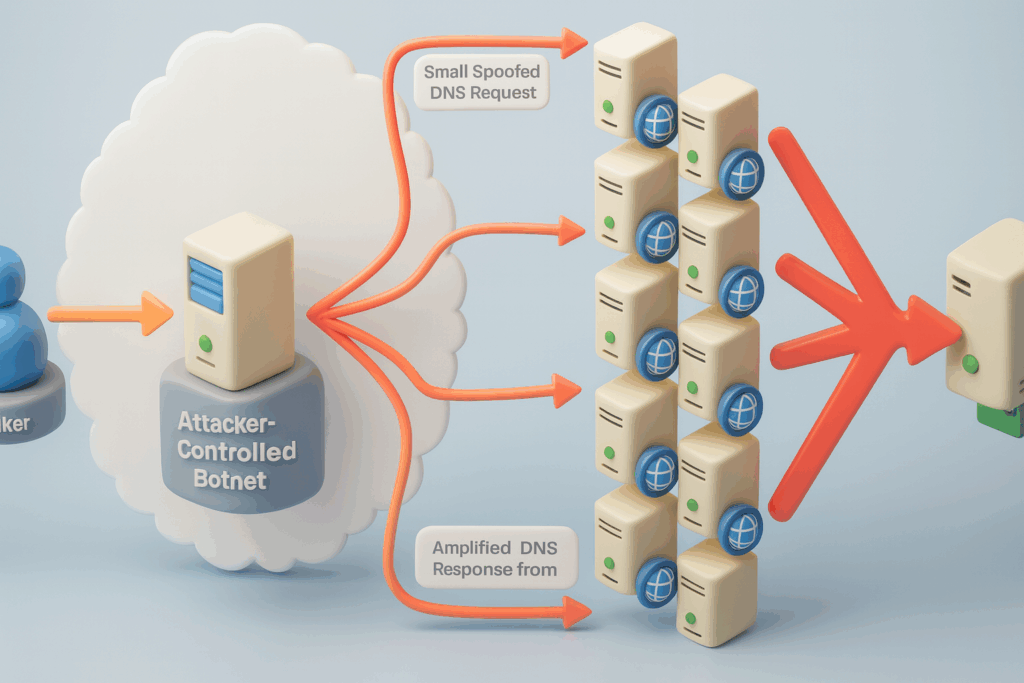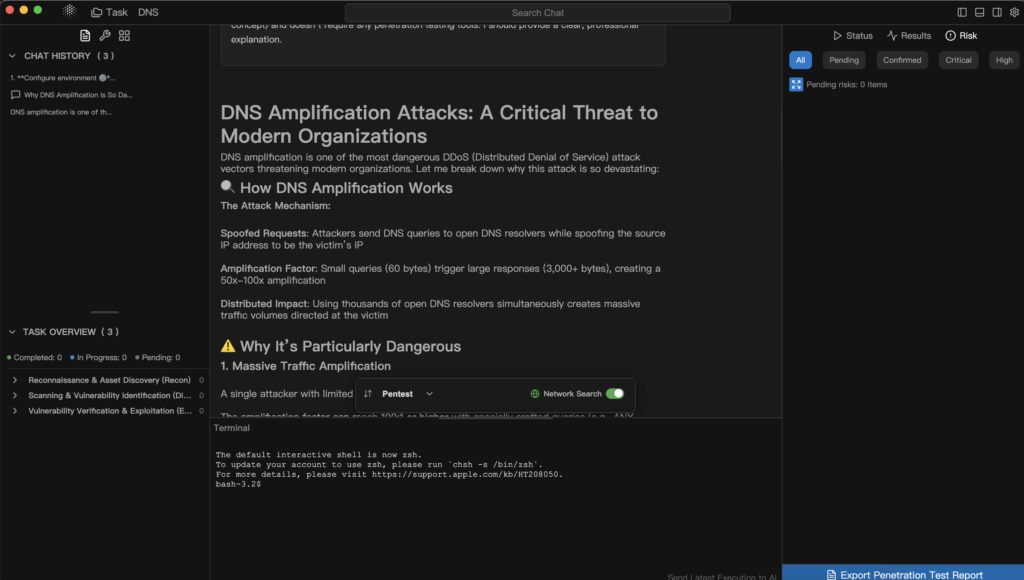A DNS amplification attack is a type of distributed denial-of-service (DDoS) attack in which an attacker sends a small, spoofed DNS query to an open DNS server, causing the server to return a massively larger response to an unsuspecting victim. In other words, a tiny request triggers a huge response that floods the target with overwhelming traffic. It is dangerous because it requires minimal attacker resources, is extremely difficult to trace due to IP spoofing, and can generate hundreds of times more traffic than what was originally sent—resulting in massive outages for businesses, ISPs, and critical online services.
Understanding DNS Amplification and Reflective DDoS Attacks
At its core, a DNS amplification attack relies on two long-standing characteristics of the Domain Name System: DNS uses UDP by default, and UDP does not validate the source IP address. When an attacker forges the victim’s IP as the source of a DNS request, any DNS server that responds will unknowingly blast the victim with the reply.
This makes DNS servers ideal “reflectors.” The attacker doesn’t need to contact the victim directly. Instead, open resolvers and misconfigured DNS servers become traffic cannons. Because DNS responses—especially ANY or DNSSEC-related responses—contain significantly more data than the initial queries, the attacker gains an amplification effect, multiplying their impact with almost no additional effort.

How DNS Amplification Works: A Technical Walkthrough
Although the attack is conceptually simple, the traffic mechanics are elegant in a malicious way. A typical attack unfolds in four steps:
- The attacker spoofs the victim’s IP address.
- The attacker sends thousands (or millions) of DNS queries to open DNS resolvers.
- Those resolvers return large DNS responses to the spoofed address.
- The flood of unsolicited data overwhelms the victim.
A typical forged request might look like this at the packet level:
yaml
Source IP: Victim IP (spoofed)
Destination IP: 8.8.8.8
Protocol: UDP/53
Query Type: ANY
Query: example.com
The attacker may only send a 60-byte request, but the DNS resolver could return several kilobytes of data—sometimes even tens of thousands of bytes in advanced forms of amplification.
This asymmetric exchange is where the real danger lies: the attacker invests almost nothing, but the victim pays the price.
Amplification Factors: Why “Small In, Huge Out” Is Devastating
Different DNS query types lead to different levels of amplification. The disparity can be staggering:
| Query Type | Request Size | Response Size | Amplification Factor |
|---|---|---|---|
| A Record | 60 bytes | 512 bytes | ~8.5x |
| ANY | 60 bytes | 3,500 bytes | ~58x |
| DNSSEC | 70 bytes | 4,000+ bytes | ~57x |
| NXNSAttack | 60 bytes | 40,000+ bytes | 600x+ |
What makes this especially threatening is scale. A botnet using only modest bandwidth—say 100 Mbps—can generate multiple Gbps of outbound DNS response traffic during amplification. Cloudflare and CISA have documented multiple real-world DDoS attacks exceeding hundreds of Gbps through DNS amplification alone.
Simulating a DNS Amplification Attack in a Controlled Lab
To understand how attackers operate, researchers and penetration testers often simulate DNS amplification in isolated, legally authorized environments. A simple proof-of-concept using Python and Scapy illustrates how easy it is to trigger amplification:
python
from scapy.all import *
target = "192.168.1.10" # Victim (spoofed IP)
dns_server = "192.168.1.53" # Open DNS resolver
packet = IP(src=target, dst=dns_server)/UDP(dport=53)/DNS(rd=1, qd=DNSQR(qname="example.com", qtype="ANY"))
for i in range(1000):
send(packet, verbose=0)
print("DNS amplification simulation sent.")
This script emphasizes two harsh realities:
- The attacker never contacts the victim directly.
- The DNS server becomes the unwilling accomplice.
- Minimal bandwidth can produce massive impact.
It is a vivid example of how asymmetric the attack truly is.
Why DNS Amplification Is So Dangerous for Modern Organizations
The risk extends far beyond traffic spikes. DNS amplification carries systemic consequences:
- Low Cost for Attackers: No high-bandwidth infrastructure required.
- Difficult Attribution: IP spoofing obscures the attacker’s identity.
- Global Attack Surface: Millions of open resolvers remain exposed.
- Collateral Damage: DNS providers, CDNs, cloud platforms, and ISPs suffer downstream disruption.
During a large-scale amplification attack, organizations often report:
| Metric | Normal Traffic | During Attack |
|---|---|---|
| DNS QPS | 1,200 | 480,000 |
| Outbound Mbps | 40 Mbps | 2.9 Gbps |
| ANY Query Ratio | <1% | 86% |
| Top Source IPs | Predictable | Spoofed / Randomized |
Even well-architected networks can crumble under this volume.
Detecting DNS Amplification Early: Logs, Rules, and Traffic Patterns
Because traffic appears “legitimate”—DNS replies to DNS queries—traditional firewalls often miss amplification attacks. Detection requires behavior-based monitoring.
Suricata Detection Rule
This rule flags suspicious surges in ANY queries:
yaml
alert dns any any -> any any (
msg:"Possible DNS Amplification Attack";
dns_query_type == ANY;
threshold:type both, track by_src, count 50, seconds 1;
sid:100001;
)
DNS Log Analysis with SQL
A SIEM can surface anomalies instantly:
sql
SELECT source_ip, COUNT(*) as queries
FROM dns_logs
WHERE query_type = 'ANY'
GROUP BY source_ip
HAVING COUNT(*) > 5000;
Sudden spikes in ANY queries are often a prelude to a full-scale attack.

Defending Against DNS Amplification: Practical, Actionable Techniques
Unlike some DDoS variants, DNS amplification can be significantly mitigated with proper configuration.
Disable Open Recursion in BIND
bind
options {
recursion no;
allow-query { trusted; };
};
acl "trusted" {
192.168.1.0/24;
};
Restricting recursion ensures the DNS server cannot be abused by the public internet.
Enable Response Rate Limiting (RRL)
bind
rate-limit {
responses-per-second 5;
window 5;
slip 2;
};
RRL throttles repetitive responses and reduces amplification potential dramatically.
Implement IP Anti-Spoofing (BCP 38) via iptables
bash
iptables -A INPUT -s 10.0.0.0/8 -j DROP
iptables -A INPUT -s 172.16.0.0/12 -j DROP
iptables -A INPUT -s 192.168.0.0/16 -j DROP
This prevents forged private address ranges from entering the network—one of the most common spoofing vectors.
Monitor ANY and DNSSEC Ratios
A surge in ANY queries is rarely benign.
Penetration Testing and Automated Validation with Penligent
While manual auditing is crucial, DNS infrastructure today is too large and dynamic to test once and forget. Misconfigurations—even minor ones—can reintroduce amplification risk.
This is where platforms like Penligent, an intelligent automated penetration testing system, offer meaningful value:
DNS Misconfiguration Scanning
Penligent can automatically identify:
- Open resolvers exposed to the public
- Missing or misconfigured RRL
- DNSSEC amplification risks
- Recursion policies that allow abuse
Future Threats: From NXNSAttack to Reflector Rotation
Recent research highlights a disturbing trend: attackers are moving beyond classic ANY amplification. Techniques like NXNSAttack exploit referral chains to generate extreme amplification, while “reflector rotation” uses large pools of DNS servers to avoid filtering and blacklisting.
The takeaway is stark: amplification is evolving, and defenders must evolve with it.
Conclusion
A DNS amplification attack is one of the most efficient and destructive forms of DDoS because it weaponizes legitimate infrastructure against innocent targets. It turns DNS servers into amplifiers, transforms tiny queries into massive floods, and hides the attacker behind forged IP addresses. The combination of low effort, high impact, and global scalability makes it a threat that modern organizations cannot ignore.
The good news is that with proper configuration—disabling open recursion, enabling RRL, enforcing anti-spoofing, monitoring traffic anomalies, and routinely testing DNS posture—organizations can drastically reduce their exposure. For environments where DNS scale is large or constantly shifting, automated platforms like Penligent can help ensure that vulnerabilities don’t reappear unnoticed.
In a world where uptime, availability, and trust define business success, securing DNS isn’t optional—it’s foundational.


